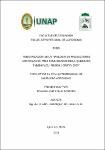| dc.contributor.advisor | Manrique del Águila, Julio Abel | |
| dc.contributor.author | Tello Paredes, Francis Jair | |
| dc.date.accessioned | 2023-07-14T18:38:37Z | |
| dc.date.available | 2023-07-14T18:38:37Z | |
| dc.date.issued | 2023 | |
| dc.identifier.uri | https://hdl.handle.net/20.500.12737/9199 | |
| dc.description.abstract | This work was carried out in the year 2020, Fernando Lores district, to identify the "typology of agricultural producers" that can be considered for this area. The results were based on the criteria made by Tico (2011), and it is concluded in aspects of land tenure, 49.23% maintain areas less than or equal to 5 hectares, with a private regime (52.31%). Likewise, family labor prevails in these agricultural properties (78.46%), where cattle breeders maintain permanent staff on their land (7.69%); They are dedicated exclusively to productive activity (92.31%), with the planting of species of bread to take (cassava and banana), vegetables (sweet pepper, cucumber, caygua, etc.), Amazonian fruit trees, regional poultry farming (a form of savings to correct any family need), cattle (9.23%) and transform cassava into fariña. The production is mostly sold in the local market (64.62%), the cattle in the city of Iquitos; they do not receive information about the prices of products in the market and they tend to find out the same in the local market or from some neighbors (93.85%), they state that they do not receive advance payments for the products to be harvested (92.31%).
They did not attend any agricultural training event, only the cattle farms received this training in sanitary aspects; For the sowing of their crops they use their own seeds derived from previous harvests (83.08%), certified vegetable seeds are purchased. They use pesticides like Aldrin for their old knowledge and organic fertilizers. They generate income from agricultural activity less than or equal to S/. 700.0, which is financed with own resources. Most of them do not calculate their production costs, only 4.62% carry out this action.
Executed the study, it was evidenced that the proposed general hypothesis is fulfilled and for the study these productive units are considered as small agriculture in transformation, it is fulfilled, performing for the same, the possession of lands of less than 0.5 Hectares, use of labor Family work, sale of diverse products emanating from the total agricultural activity, with low income from the activity. | en_US |
| dc.description.abstract | Este trabajo se llevó a cabo en el año 2020, distrito de Fernando Lores, para identificar la “tipología de productores agrícolas” que se pueden considerar para esta zona. Los resultados se basaron en los criterios hechos por Tico (2011), y se concluye en aspectos de tenencia de tierra, el 49.23% mantiene áreas menores o iguales a 5 hectáreas, con régimen privado (52.31%). Así mismo la mano de obra familiar prevalece en estos predios agrícolas (78.46%), donde los criadores de ganado vacuno mantienen personal permanente en sus terrenos (7.69%); se dedican exclusivamente a la actividad productiva (92.31%), con la siembra de especies de pan llevar (yuca y Plátano) hortalizas (ají dulce, pepino, caygua, etc.) frutales amazónicos, crianza de aves regionales (forma de ahorro para subsanar cualquier necesidad familiar), ganado vacuno (9.23%) y transforman yuca en fariña. La producción en su mayoría se comercializa en el mercado local (64.62%), los vacunos en la ciudad de Iquitos; no reciben información sobre los precios de productos en el mercado y estos tienden averiguar los mismos en el mercado local o por algunos vecinos (93.85%), manifiestan no recibir pagos adelantados por los productos a cosechar (92.31%).
No asistieron a ningún evento de capacitación agrícola, solo los criaderos de vacuno recibieron esta capacitación en aspectos sanitarios; para la siembra de sus cultivos utilizan sus propias semillas derivadas de cosechas anteriores (83.08%), se adquieren semillas certificadas de hortalizas. Utilizan pesticidas como Aldrin por su conocimiento de antaño y abonos orgánicos. Generan ingresos por la actividad agrícola menores o iguales a S/. 700.0, el cual es financiado con recursos propios. No calculan sus costos de producción en su mayoría, solo el 4.62% realiza esta acción.
Ejecutado el estudio, se evidenció que la hipótesis general propuesta, se cumple y para el estudio estas unidades productivas se consideran como agricultura pequeña en transformación, se cumple, desempeñando para el mismo, la tenencia de tierras menores a 0.5 Hectáreas, uso de mano de obra familiar, venta de productos diversos emanados de la actividad agrícola total, con bajos ingresos por la actividad. | es_PE |
| dc.format | application/pdf | es_PE |
| dc.language.iso | spa | es_PE |
| dc.publisher | Universidad Nacional de la Amazonía Peruana | es_PE |
| dc.rights | info:eu-repo/semantics/openAccess | * |
| dc.rights.uri | https://creativecommons.org/licenses/by/4.0/ | * |
| dc.subject | Productividad agrícola | es_PE |
| dc.subject | Población activa | es_PE |
| dc.subject | Pequeños agricultores | es_PE |
| dc.subject | Tipología | es_PE |
| dc.subject | Zonas rurales | es_PE |
| dc.title | Identificación de la tipología de productores agrícolas en tres comunidades de la quebrada Tamshiyacu. Región Loreto. 2020 | es_PE |
| dc.type | info:eu-repo/semantics/bachelorThesis | es_PE |
| thesis.degree.discipline | Agronomía | es_PE |
| thesis.degree.grantor | Universidad Nacional de la Amazonía Peruana. Facultad de Agronomía | es_PE |
| thesis.degree.name | Ingeniero(a) Agrónomo | es_PE |
| dc.subject.ocde | https://purl.org/pe-repo/ocde/ford#4.01.01 | es_PE |
| renati.author.dni | 71235249 | |
| renati.advisor.orcid | https://orcid.org/0000-0001-5728-118X | |
| renati.advisor.dni | 05221163 | |
| renati.type | https://purl.org/pe-repo/renati/type#tesis | es_PE |
| renati.discipline | 811036 | es_PE |
| renati.level | https://purl.org/pe-repo/renati/level#tituloProfesional | es_PE |
| renati.juror | Chavez Vasquez, Rafael | |
| renati.juror | Yalta Vega, Ronald | |
| renati.juror | Avila Fucos, Manuel Calixto | |
| dc.publisher.country | PE | es_PE |





